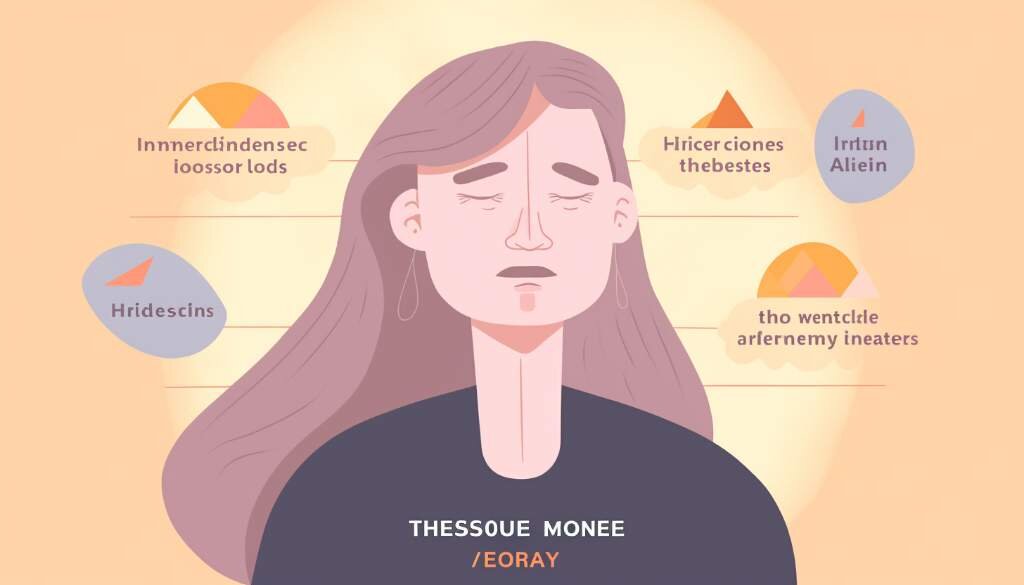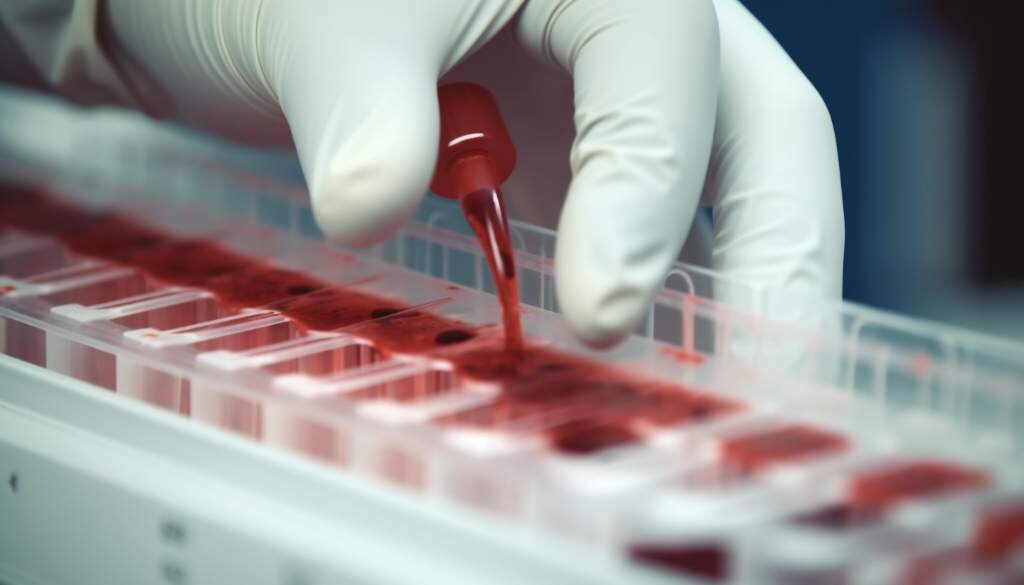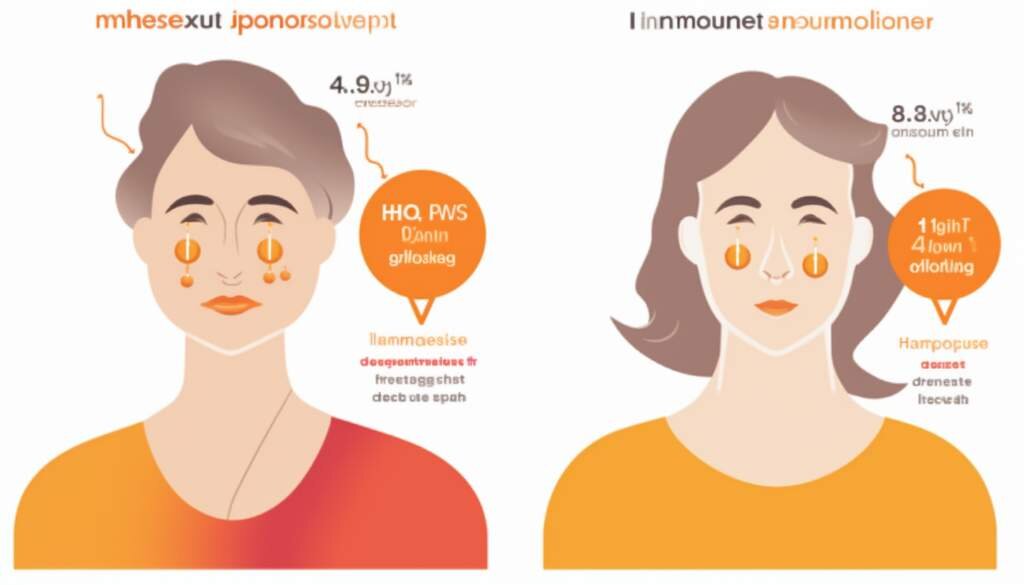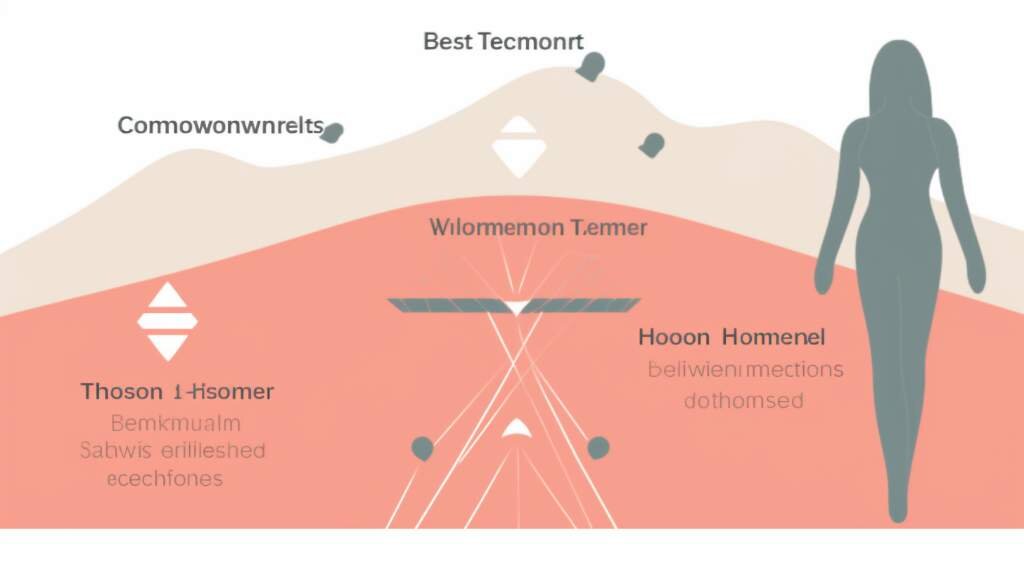
1. Overview
Testosterone is a hormone that plays a vital role in both men and women. In this section, we will explore the various aspects of testosterone in women and how it affects their overall health and well-being.
Firstly, let's understand what testosterone is. Testosterone is a hormone primarily produced in the ovaries and adrenal glands of women. It is often associated with male characteristics, but it is also essential for women's health.
In the following sub-sections, we will delve into the symptoms and causes of low testosterone in women, how testosterone levels are diagnosed and tested, and various management and treatment options available for low testosterone.
Additionally, we will discuss how living with low testosterone can impact women's emotional and physical well-being, and provide coping strategies and tips for improving the quality of life.
Furthermore, we will explore the connection between testosterone and perimenopause/menopause, as well as the controversy surrounding testosterone use during this period. We will examine the evidence supporting testosterone use and its potential benefits.
To ensure a complete picture, we will also address the safety and efficacy of testosterone in women, including the side effects and risks associated with its use. We will provide guidelines for safe testosterone use, backed by research findings and meta-analyses.
What is Testosterone?
Testosterone is a hormone that is predominantly associated with males, but it is also present in females at lower levels. It is primarily produced in the testicles in men and in the ovaries in women, although the adrenal glands also contribute to its production in both genders.
Testosterone plays a crucial role in various bodily functions, including the development and maintenance of sexual characteristics, muscle mass, and bone density. It is also involved in mood regulation, cognitive function, and overall well-being.
In women, testosterone is essential for maintaining a healthy libido, regulating menstrual cycles, and contributing to overall sexual satisfaction. It also helps in the production of estrogen, another important hormone for women. Testosterone levels in females are highest during the reproductive years and decline steadily with age, especially during menopause.
The Role of Testosterone in Women
Testosterone is often thought of as a male hormone, but it also plays a vital role in women's health. While women have lower levels of testosterone compared to men, this hormone is still essential for various bodily functions and overall well-being.
One of the primary roles of testosterone in women is maintaining sexual desire and function. It contributes to a healthy libido and is crucial for sexual arousal. In addition, testosterone helps maintain vaginal health by promoting blood flow and lubrication.
Beyond sexual health, testosterone also plays a role in maintaining bone density. It helps prevent the loss of bone mass and reduces the risk of osteoporosis in women. Testosterone contributes to muscle strength and overall physical performance as well.
Testosterone also affects mood and cognitive function in women. Adequate levels of testosterone can improve mood, energy levels, and overall sense of well-being. Furthermore, it plays a role in cognitive function, including memory and mental clarity.
Another important function of testosterone in women is its impact on body composition. Testosterone helps maintain lean muscle mass and aids in fat distribution. Adequate levels of this hormone can contribute to a healthier body composition and promote weight management.
It's important to note that testosterone levels naturally decline with age in both men and women. However, women may experience a more significant decrease in testosterone during perimenopause and menopause. This decline can lead to various symptoms such as decreased libido, fatigue, mood swings, and reduced muscle mass.
In conclusion, testosterone plays a multifaceted role in women's health, contributing to sexual function, bone density, mood, cognition, and body composition. Understanding the role of testosterone in women is essential for identifying and managing any imbalances that may arise.

2. Symptoms and Causes of Low Testosterone in Women
Low testosterone in women refers to abnormally low levels of the hormone testosterone in the female body. While testosterone is often associated with males, it is also present in females and plays a crucial role in various bodily functions.
In this section, we will explore the symptoms and causes of low testosterone in women. We will discuss the common symptoms that women with low testosterone may experience and the factors that can contribute to low testosterone levels in females.
Common Symptoms of Low Testosterone
Low testosterone in women can have various symptoms that can affect overall well-being. These symptoms are often non-specific, which means they can be attributed to other conditions as well. However, when experienced collectively, they can be indicative of low testosterone levels. Here are some common symptoms of low testosterone in women:
- Decreased libido: One of the primary symptoms of low testosterone in women is a decrease in sexual desire or libido. Women may find that they have little to no interest in engaging in sexual activity or lack the arousal they once had.
- Fatigue and low energy: Women with low testosterone levels may experience constant fatigue and a lack of energy. They may feel tired even after getting enough rest and have difficulty completing everyday tasks.
- Depression: Low testosterone can contribute to feelings of sadness, low mood, and even depression in women. It can affect emotional well-being and lead to a loss of interest in activities that were once enjoyed.
- Muscle weakness and loss of strength: Testosterone plays a role in maintaining muscle mass and strength. Women with low testosterone levels may notice a decline in their physical strength and muscle tone.
- Weight gain: Low testosterone can also contribute to weight gain, particularly an increase in body fat. Women may notice a change in their body composition, with more fat accumulating around the abdomen.
- Hot flashes: While commonly associated with menopause, hot flashes can also be a symptom of low testosterone in women. These sudden feelings of warmth and flushing can be bothersome and disruptive to daily life.
- Brain fog and difficulty concentrating: Hormonal imbalances, including low testosterone, can affect cognitive function in women. They may experience difficulty concentrating, memory problems, and an overall sense of mental fogginess.
If you are experiencing any combination of these symptoms, it is important to consult with a healthcare professional to determine the underlying cause and explore potential treatments.
Causes of Low Testosterone
Several factors can contribute to low testosterone levels in women. Understanding these causes can help in identifying and addressing the underlying issues.
- Hormonal Imbalance: Hormonal imbalances can disrupt the production and regulation of testosterone in women. Conditions such as polycystic ovary syndrome (PCOS) can cause an overproduction of androgens, leading to low testosterone levels.
- Aging: As women age, their hormone levels naturally decline. This hormonal decline, including a decrease in testosterone, is a normal part of the aging process. However, some women may experience a more significant drop in testosterone levels, leading to symptoms of low testosterone.
- Menopause: The hormonal changes that occur during menopause can also contribute to low testosterone levels in women. Estrogen and progesterone levels decline during menopause, which can affect the production and balance of testosterone. Post-menopausal women are more likely to experience low testosterone levels.
- Stress and Chronic Illness: Chronic stress and certain medical conditions can impact hormone production in women. Conditions such as diabetes, obesity, thyroid disorders, and adrenal dysfunction can disrupt the delicate hormone balance, potentially leading to low testosterone.
- Medications and Treatments: Some medications and treatments can interfere with testosterone production and regulation in women. For example, certain contraceptives, steroid medications, and hormone-based therapies may affect testosterone levels.
It is important to note that the causes of low testosterone can vary from woman to woman. A comprehensive evaluation by a healthcare professional is essential to determine the specific factors contributing to low testosterone levels.

3. Diagnosing and Testing Testosterone Levels
Diagnosing and Testing Testosterone Levels involves the evaluation and measurement of testosterone hormone levels in the body. This process helps healthcare professionals determine if an individual has low or high testosterone levels, which can be indicative of certain medical conditions. By diagnosing and testing testosterone levels, healthcare providers are able to develop appropriate treatment plans and interventions to address hormonal imbalances and their associated symptoms.
In the following sections, we will explore the various methods for testing testosterone levels as well as interpreting the test results. We will also discuss the different factors that can contribute to low testosterone levels and the common symptoms experienced by individuals with low testosterone. Additionally, we will provide insights into the management and treatment options available for addressing low testosterone, along with tips for improving quality of life while living with this condition.
Furthermore, we will delve into the relationship between testosterone and perimenopause/menopause, examining the controversies and the evidence supporting the use of testosterone during this stage of life. We will also touch upon the safety and efficacy of testosterone therapy in women, including potential side effects, risks, and guidelines for safe usage based on research findings and meta-analyses.
Methods for Testing Testosterone Levels
When it comes to diagnosing and testing testosterone levels in women, there are several methods available that healthcare professionals use to determine the hormone levels in the body. These methods include:
- Blood Tests: Blood tests are the most common method used to measure testosterone levels. A healthcare provider will collect a blood sample, usually from a vein in the arm, and send it to a laboratory for analysis. The test measures the total testosterone levels in the blood, as well as the levels of other hormones that may be involved in testosterone production and metabolism.
- Saliva Tests: Saliva tests are another option for measuring testosterone levels. These tests involve collecting a saliva sample, typically by spitting into a tube or using a swab to collect saliva from the mouth. Saliva tests are often used to measure bioavailable testosterone, which is the portion of testosterone that is free and active in the body.
- Urine Tests: Urine tests can also be used to assess testosterone levels. These tests measure the amount of testosterone and its metabolites excreted in the urine. Urine tests are less commonly used than blood or saliva tests but may be helpful in certain situations, such as monitoring testosterone levels over a longer period of time.
It's important to note that the accuracy and reliability of these tests may vary, and it's always best to consult with a healthcare professional to determine the most appropriate method for testing testosterone levels. Additionally, the timing of the test within the menstrual cycle may also be taken into consideration, as testosterone levels fluctuate throughout the month.
Interpreting Testosterone Test Results
Interpreting testosterone test results is crucial in diagnosing and managing low testosterone levels in women. The results of a testosterone test can provide valuable information about a woman's hormonal balance and help determine the appropriate course of treatment. Here are some key points to consider when interpreting testosterone test results:
- Reference Ranges: Testosterone levels can vary depending on factors such as age, menstrual cycle phase, and the laboratory conducting the test. It's important to compare the test results with the reference ranges provided by the specific laboratory to determine if the levels fall within the normal range for women.
- Total Testosterone vs. Free Testosterone: Testosterone exists in the blood in two forms – bound to proteins (total testosterone) and unbound or available for use by the body (free testosterone). While total testosterone levels can indicate the overall production of the hormone, free testosterone levels are a better indicator of its bioavailability. Both forms should be considered when interpreting test results.
- Timing of the Test: Testosterone levels fluctuate throughout the day, with the highest levels typically occurring in the morning. To ensure accurate results, the test should be performed in the morning, preferably around 8 a.m. Additionally, for premenopausal women, the timing of the test should be considered in relation to their menstrual cycle phase, as testosterone levels can vary across different phases.
- Other Hormones: Testosterone production can be influenced by other hormones, such as estrogen and follicle-stimulating hormone (FSH). It's important to consider these hormonal interactions when interpreting testosterone test results. Abnormal levels of estrogen or FSH can affect testosterone levels and vice versa.
- Symptoms and Clinical Presentation: Testosterone test results should be interpreted in conjunction with the individual's clinical symptoms. Low testosterone symptoms may include fatigue, low libido, mood changes, and decreased muscle mass. High testosterone symptoms can include acne, hirsutism (excessive hair growth), and menstrual irregularities. The correlation between symptoms and test results can help guide diagnosis and treatment decisions.
Interpreting testosterone test results requires careful consideration of various factors. Consulting with a healthcare professional or an endocrinologist experienced in hormone management is essential to accurately interpret the results and develop an appropriate treatment plan.

4. Management and Treatment of Low Testosterone
Management and treatment of low testosterone in women involves various approaches to address the hormonal imbalance. These methods aim to alleviate symptoms, improve quality of life, and restore hormonal balance.
In this section, we will explore the different strategies and options available for managing and treating low testosterone in women, including lifestyle changes, hormone replacement therapy, and other treatment approaches. We will also discuss coping strategies for the emotional and physical impact of low testosterone and provide tips for improving overall quality of life.
Additionally, we will delve into the relationship between testosterone and perimenopause/menopause, exploring the controversies surrounding testosterone use during these life stages and examining the evidence that supports its benefits.
Finally, we will discuss the safety and efficacy of testosterone in women, including common side effects and risks. We will provide guidelines for the safe use of testosterone and highlight relevant research findings and meta-analyses.
Lifestyle Changes for Managing Low Testosterone
Lifestyle Changes for Managing Low Testosterone
Managing low testosterone in women often involves making certain lifestyle changes that can help improve symptoms and overall well-being. While lifestyle changes alone may not completely restore testosterone levels to normal, they can have a positive impact on managing the symptoms associated with low testosterone.
Here are some lifestyle changes that can be beneficial:
- Healthy Diet: Adopting a balanced and nutritious diet can play a crucial role in managing low testosterone. Include a variety of fruits, vegetables, whole grains, lean proteins, and healthy fats in your diet. It is also important to limit the consumption of processed foods, sugary snacks, and excessive alcohol, as these can negatively impact hormonal balance.
- Regular Exercise: Engaging in regular physical activity can help increase testosterone levels in women. Incorporate both cardiovascular exercises and strength training into your routine. Aim for at least 150 minutes of moderate-intensity aerobic exercise or 75 minutes of vigorous-intensity exercise each week, along with strength training exercises at least twice a week.
- Weight Management: Achieving and maintaining a healthy weight is important for hormonal balance. Excess body fat can contribute to lower testosterone levels. If you are overweight, even a small amount of weight loss can have a positive impact on testosterone levels.
- Adequate Sleep: Getting enough restful sleep is essential for overall health and hormonal balance. Aim for 7-9 hours of quality sleep each night. Establish a consistent sleep routine and create a sleep-friendly environment by keeping your bedroom dark, quiet, and cool.
- Stress Management: Chronic stress can have a negative impact on hormone production, including testosterone. Practice stress management techniques like deep breathing exercises, meditation, yoga, or engaging in activities that you enjoy and help you relax.
- Supplements: In some cases, certain supplements may be recommended to support hormonal balance and manage symptoms of low testosterone. However, it is important to consult with a healthcare professional before starting any supplements to ensure they are safe and appropriate for your individual needs.
By implementing these lifestyle changes, you can proactively manage low testosterone symptoms and improve your overall well-being. It is important to remember that while lifestyle changes can be beneficial, they should not replace medical treatment or hormone replacement therapy when necessary. Consult with a healthcare professional for personalized advice and guidance.
Hormone Replacement Therapy Options
Hormone replacement therapy (HRT) is a common treatment option for women with low testosterone levels. It involves supplementing the body with hormones to restore hormonal balance and alleviate symptoms associated with low testosterone. HRT typically involves the use of synthetic hormones, but bioidentical hormones may also be an option.
There are several hormone replacement therapy options available for women with low testosterone:
- Oral Medications: One of the most common forms of HRT for low testosterone in women is oral medications. These medications contain synthetic hormones that are absorbed through the digestive system. They are convenient to use but may have a higher risk of side effects.
- Topical Gels and Creams: Another popular form of HRT is the use of topical gels or creams. These products are applied to the skin, allowing the hormones to be absorbed directly into the bloodstream. It provides a steady release of hormones and is generally well-tolerated.
- Patches: Hormone replacement patches are also available for women with low testosterone. These patches are applied to the skin and slowly release hormones over time. They offer a convenient and consistent delivery of hormones.
- Injections: In some cases, testosterone injections may be recommended to increase testosterone levels in women. These injections are typically administered by a healthcare professional and provide a quick boost of hormones.
- Implants: Hormone implants are small pellets that are inserted under the skin. They gradually release hormones into the body over several months. Implants offer a long-lasting and low-maintenance form of hormone replacement therapy.
It is important to note that hormone replacement therapy should only be undertaken after consulting with a healthcare professional. They will evaluate your specific hormone levels, medical history, and individual needs to determine the most appropriate form of HRT for you. Close monitoring and regular follow-ups are necessary to ensure the treatment is effective and safe.
Other Treatment Approaches
When it comes to managing low testosterone in women, there are various treatment approaches that can be considered apart from hormone replacement therapy (HRT). While HRT is a common method, it may not be suitable for every individual due to various factors such as medical history, personal preferences, or potential side effects. In such cases, alternative treatment approaches can be explored to alleviate the symptoms and improve overall well-being.
One of the alternative treatment approaches for low testosterone in women is the use of supplements. Certain supplements, such as DHEA (dehydroepiandrosterone), have shown promising results in increasing testosterone levels. However, it is important to consult with a healthcare professional before starting any supplement regimen, as they can assess the individual's specific needs and provide guidance on the appropriate dosage and safety.
Another approach that has gained attention is lifestyle modifications. Simple changes in diet and exercise can have a positive impact on testosterone levels. Consuming a balanced diet that includes foods rich in zinc, vitamin D, and omega-3 fatty acids can support hormonal balance. Regular exercise, especially strength training, has been shown to stimulate testosterone production in both men and women.
Stress management techniques can also play a role in managing low testosterone levels. Chronic stress can disrupt hormone production, leading to imbalances. Practices such as yoga, meditation, deep breathing exercises, and engaging in hobbies or activities that promote relaxation can help reduce stress levels and improve overall hormone function.
Additionally, certain medications may contribute to low testosterone in women. If a specific medication is identified as the cause, the healthcare provider may explore alternative medications or adjust the dosage to improve testosterone levels. It is crucial to discuss any potential side effects or concerns with the prescribing healthcare professional before making any changes to medication regimens.
It is worth mentioning that the effectiveness of these alternative treatment approaches may vary from person to person. What works for one individual may not work for another. Therefore, it is recommended to work closely with a healthcare professional who specializes in hormone health to determine the most suitable treatment approach based on individual circumstances and needs.

5. Living With Low Testosterone
Living with low testosterone can have a significant impact on a woman's overall well-being. From emotional and physical changes to managing daily life, it is important to understand the challenges and explore ways to improve quality of life.
In this section, we will discuss various aspects of living with low testosterone, including coping strategies for the emotional and physical impact and tips for improving overall quality of life. Additionally, we will explore the connection between testosterone and perimenopause/menopause, examining the controversy surrounding its use and the evidence supporting its benefits.
Furthermore, we will delve into the safety and efficacy of testosterone in women, highlighting the potential side effects and risks associated with its use. We will also provide guidelines for the safe use of testosterone and discuss relevant research findings and meta-analyses.
Coping Strategies for Emotional and Physical Impact
Living with low testosterone can have both emotional and physical impacts on women. Coping with these effects is important for maintaining a good quality of life. Here are some strategies to help manage the emotional and physical impact of low testosterone:
- Seek emotional support: Dealing with the emotional effects of low testosterone can be challenging. It can lead to mood swings, depression, and anxiety. It is important to reach out to loved ones, friends, or a support group to talk about your feelings and seek support. Counseling or therapy can also provide helpful strategies for coping with emotional challenges.
- Stay physically active: Regular exercise has been shown to have positive effects on hormone balance and mood. Engaging in activities like walking, jogging, yoga, or strength training can help improve your overall well-being and reduce symptoms of low testosterone.
- Eat a balanced diet: A healthy diet plays a crucial role in hormone regulation. Include foods rich in vitamins, minerals, and antioxidants. Focus on whole grains, lean proteins, fruits, vegetables, and healthy fats. Avoid processed foods, sugary snacks, and excessive caffeine, as they can worsen symptoms.
- Manage stress levels: High levels of stress can further disrupt hormone balance and contribute to emotional and physical symptoms. Incorporate stress management techniques into your daily routine, such as deep breathing exercises, meditation, or engaging in activities you enjoy.
- Get enough sleep: Adequate sleep is essential for hormone production and overall well-being. Aim for 7-9 hours of uninterrupted sleep each night. Establish a consistent sleep routine, create a comfortable sleep environment, and limit electronic devices before bedtime.
Tips for Improving Quality of Life
Living with low testosterone can impact a woman's quality of life in various ways. Fortunately, there are several tips and strategies that can help improve overall well-being and enhance daily living. Here are some suggestions:
- Exercise regularly: Engaging in regular physical activity can have numerous benefits for women with low testosterone. Exercise can help increase energy levels, improve mood, strengthen muscles and bones, and enhance overall health. Consider incorporating a mix of cardiovascular exercises, strength training, and flexibility exercises. It's important to consult with a healthcare provider to determine the exercise program that is suitable for individual needs and abilities.
- Eat a balanced diet: Good nutrition is essential for maintaining optimal health and well-being, especially for women with low testosterone. Aim to include a variety of fruits, vegetables, whole grains, lean proteins, and healthy fats in your diet. Additionally, ensure that you are getting enough essential nutrients like vitamin D and calcium, which are important for bone health.
- Manage stress: Chronic stress can negatively impact hormone levels, including testosterone. Finding effective ways to manage stress can be beneficial for women with low testosterone. Consider incorporating stress-reducing techniques into your daily routine, such as practicing mindfulness, deep breathing exercises, engaging in hobbies or activities that you enjoy, and getting enough sleep.
- Get enough sleep: A good night's sleep is crucial for overall well-being. Lack of sleep can disrupt hormone levels and contribute to feelings of fatigue and low energy. Aim for 7-8 hours of quality sleep each night. Establish a regular sleep schedule, create a comfortable sleep environment, and practice good sleep hygiene habits.
- Maintain a healthy weight: Excess body weight, especially abdominal fat, can contribute to hormonal imbalances, including low testosterone. Maintaining a healthy weight through a combination of regular exercise and a balanced diet can help optimize hormone levels. If weight loss is a goal, consider working with a healthcare professional or a registered dietitian to develop a personalized weight management plan.
- Seek emotional support: Living with low testosterone can have emotional effects, such as mood swings, depression, and irritability. Connecting with supportive friends and family members can provide emotional support. Additionally, consider joining a support group or seeking therapy to explore coping mechanisms and strategies.
By implementing these tips for improving quality of life, women with low testosterone can take proactive steps towards managing their condition and enhancing overall well-being.

6. Testosterone and Perimenopause/Menopause
During perimenopause and menopause, a woman's hormone levels undergo significant changes. One hormone that plays a crucial role during this time is testosterone. Testosterone is often associated with men, but it is also present in women and has important functions in their bodies.
6. Testosterone and Perimenopause/Menopause explores the relationship between testosterone and the transitional phase of perimenopause and menopause. This section will delve into the controversy surrounding the use of testosterone during this time and present evidence supporting its use. It will also discuss the various symptoms and challenges women may experience during perimenopause and menopause and how testosterone can potentially help alleviate some of these issues.
In the following sub-sections, we will explore the controversy surrounding testosterone use during perimenopause and menopause, as well as the supporting evidence. We will also discuss the potential side effects and risks associated with testosterone use, guidelines for safe use, and the findings of research studies and meta-analyses.
Understanding the Controversy
There is a significant controversy surrounding the use of testosterone in women during the perimenopause and menopause stages. The controversy mainly revolves around the safety and efficacy of testosterone therapy for women.
Many healthcare professionals are divided on the topic, with some believing that testosterone can provide numerous benefits for women experiencing hormonal imbalances during this phase of life, while others are skeptical and cautious due to limited research and concerns about potential side effects.
The controversy arises from several factors:
- Limited Research: There is a lack of comprehensive studies specifically focusing on the effects of testosterone therapy in women during perimenopause and menopause. Most of the research conducted on testosterone has been on men, which makes it challenging to draw definitive conclusions on its use for women.
- Hormone Replacement Therapy Paradigm: The traditional approach to menopausal hormone replacement therapy (HRT) has largely focused on estrogen replacement. Testosterone has not been a standard component of HRT for women, which has led to skepticism and resistance from some healthcare professionals.
- Conflicting Findings: Existing research on testosterone therapy in women has produced conflicting findings. Some studies suggest potential benefits such as improved sexual function, bone density, and mood, while others raise concerns about cardiovascular risks and adverse effects.
- Risks and Side Effects: Testosterone therapy in women is not without risks and potential side effects. These may include acne, hair growth, voice changes, fluid retention, and an increased risk of cardiovascular events. The long-term safety of testosterone use in women is still being debated.
- Individualized Approach: The controversy also stems from the recognition that hormone therapy should be individualized based on a woman's unique symptoms, medical history, and risk factors. What may work for one woman may not be suitable for another.
As a result of this controversy, it's crucial for women considering testosterone therapy to have a thorough discussion with their healthcare provider. They should weigh the potential benefits against the risks and consider alternative treatment options. Additionally, women should be aware of any ongoing clinical trials or new advancements in research that may provide more clarity on the topic.
Evidence Supporting Testosterone Use
Testosterone use in women during perimenopause and menopause is a topic surrounded by controversy. However, there is some evidence supporting its use for certain individuals. It is important to note that testosterone should be prescribed and monitored by a healthcare professional, as individual needs and risks can vary.
One area where testosterone has shown potential benefits is in improving sexual desire and function. As women age and go through hormonal changes, they may experience a decrease in libido and sexual satisfaction. Testosterone therapy may help alleviate these symptoms by increasing sexual desire and improving overall sexual well-being.
Another potential benefit of testosterone use is in the management of certain menopausal symptoms. Research has suggested that testosterone supplementation may be effective in reducing hot flashes, night sweats, and mood swings. However, the use of testosterone for this purpose is still being studied, and more research is needed to establish its efficacy and safety.
Additionally, testosterone has been linked to improved mood and cognitive function in some women. Studies have shown that testosterone therapy may help reduce symptoms of depression, fatigue, and irritability, which are common during perimenopause and menopause. It may also enhance cognitive abilities such as memory and concentration.
It is worth noting that the use of testosterone in women is not without potential side effects and risks. These can include acne, hair growth, voice changes, and an increased risk of cardiovascular events. Therefore, it is crucial to weigh the potential benefits against the risks and consider individual health factors before initiating testosterone therapy.
In conclusion, while there is some evidence supporting the use of testosterone in women during perimenopause and menopause, it is a complex and controversial topic. It is important for women to discuss their specific symptoms and concerns with a healthcare professional who can provide personalized guidance and monitor their hormone levels and overall health throughout the treatment process.

7. Safety and Efficacy of Testosterone in Women
When it comes to the safety and efficacy of testosterone in women, there are several important considerations to take into account. Testosterone, primarily known as a male hormone, also plays a significant role in women's health. In this section, we will explore the safety and efficacy of testosterone in women, examining the potential side effects and risks, as well as the guidelines for safe testosterone use.
We will also delve into the research findings and meta-analyses regarding the use of testosterone in women. Understanding the evidence supporting testosterone use is crucial in order to make informed decisions about its safety and efficacy.
Lastly, we will discuss the controversy surrounding the use of testosterone in perimenopause and menopause. By exploring different perspectives and understanding the current state of knowledge, we can gain a deeper insight into the potential benefits and risks of testosterone use during this stage of life.
Side Effects and Risks
When it comes to using testosterone in women, it is important to be aware of the potential side effects and risks. While testosterone therapy can be beneficial for some women, there are also potential risks that need to be considered.
One of the main side effects of testosterone therapy in women is the development of masculine characteristics, also known as virilization. This can include the growth of facial hair, deepening of the voice, and enlargement of the clitoris. These changes are typically irreversible and can be distressing for some women.
Other side effects of testosterone therapy may include acne, oily skin, and increased aggression or irritability. Some women may also experience mood swings or changes in libido. It is important to discuss these potential side effects with your healthcare provider before starting testosterone therapy.
In addition to potential side effects, there are also certain risks associated with testosterone therapy in women. One of the main concerns is the potential for cardiovascular problems. Testosterone can increase red blood cell production, which may lead to an increased risk of blood clots, stroke, or heart attack. Women with a history of cardiovascular disease should be cautious when considering testosterone therapy.
Another risk of testosterone therapy is the potential for liver damage. Testosterone is metabolized by the liver, and long-term use of testosterone therapy may put strain on the liver. Regular monitoring of liver function is important for women using testosterone therapy.
It is worth noting that the safety and efficacy of testosterone therapy in women is still a topic of debate among healthcare professionals. While some studies have shown positive results in terms of improving symptoms of low testosterone in women, others have raised concerns about the long-term effects and potential risks.
Overall, it is important for women considering testosterone therapy to weigh the potential benefits against the potential risks. It is recommended to consult with a healthcare provider who specializes in hormone therapy to discuss individual risks and determine if testosterone therapy is the right option.
Guidelines for Safe Testosterone Use
Guidelines for safe testosterone use in women are crucial to ensure the overall safety and efficacy of treatment. It is important to follow these guidelines to minimize risks and maximize benefits:
- Consult a healthcare professional: Before starting testosterone therapy, it is essential to consult with a healthcare professional experienced in hormone replacement therapy for women. They will assess your medical history, symptoms, and hormone levels to determine if testosterone therapy is appropriate for you.
- Individualized treatment plan: Each woman's hormone levels and needs are unique. The healthcare professional will tailor a treatment plan specific to your requirements. Dosage, frequency, and mode of administration will vary depending on your individual circumstances.
- Frequent monitoring: Throughout testosterone therapy, regular monitoring of hormone levels is necessary. This helps ensure that you are receiving the appropriate dosage and that hormone levels are within a safe range. Your healthcare professional will schedule blood tests at specific intervals to evaluate the effectiveness of treatment.
- Discuss risks and benefits: It is essential to have an open and honest discussion with your healthcare professional about the potential risks and benefits of testosterone therapy. They will educate you on the possible side effects and risks associated with treatment and help you weigh them against the potential benefits.
- Monitor for side effects: While testosterone therapy can be beneficial, it is not without risks. Monitoring for side effects is crucial. Common side effects include acne, oily skin, hair growth, and voice changes. If you experience any concerning symptoms, such as cardiovascular issues or mood changes, promptly inform your healthcare professional.
- Consider alternative treatments: Testosterone therapy may not be appropriate or suitable for all women. Depending on your specific circumstances and preferences, alternative treatments may be explored. This could include other hormone replacement therapies, lifestyle changes, or non-hormonal approaches.
Following these guidelines and working closely with a knowledgeable healthcare professional will help ensure the safe and effective use of testosterone therapy in women.
Research Findings and Meta-Analyses
In order to determine the safety and efficacy of testosterone use in women, researchers have conducted numerous studies and meta-analyses. These research findings provide valuable insights into the effects and potential risks associated with testosterone therapy for women.
One meta-analysis published in the Journal of Clinical Endocrinology and Metabolism analyzed data from multiple studies and found that testosterone therapy in postmenopausal women can improve sexual function, including increasing desire and frequency of sexual activity. Additionally, it may also improve mood, well-being, and overall quality of life.
Another meta-analysis, published in the Journal of the American Medical Association, examined the effects of testosterone therapy in women with low sexual desire. The analysis found that testosterone therapy significantly increased the number of satisfying sexual episodes per month and decreased distress related to sexual dysfunction.
It is important to note that while these studies suggest potential benefits of testosterone therapy for women, there can also be side effects and risks associated with its use. Some common side effects include acne, increased facial and body hair growth, voice deepening, and changes in cholesterol levels. It is essential for women considering testosterone therapy to consult with a healthcare professional who can evaluate their individual health status and discuss the potential risks and benefits.








